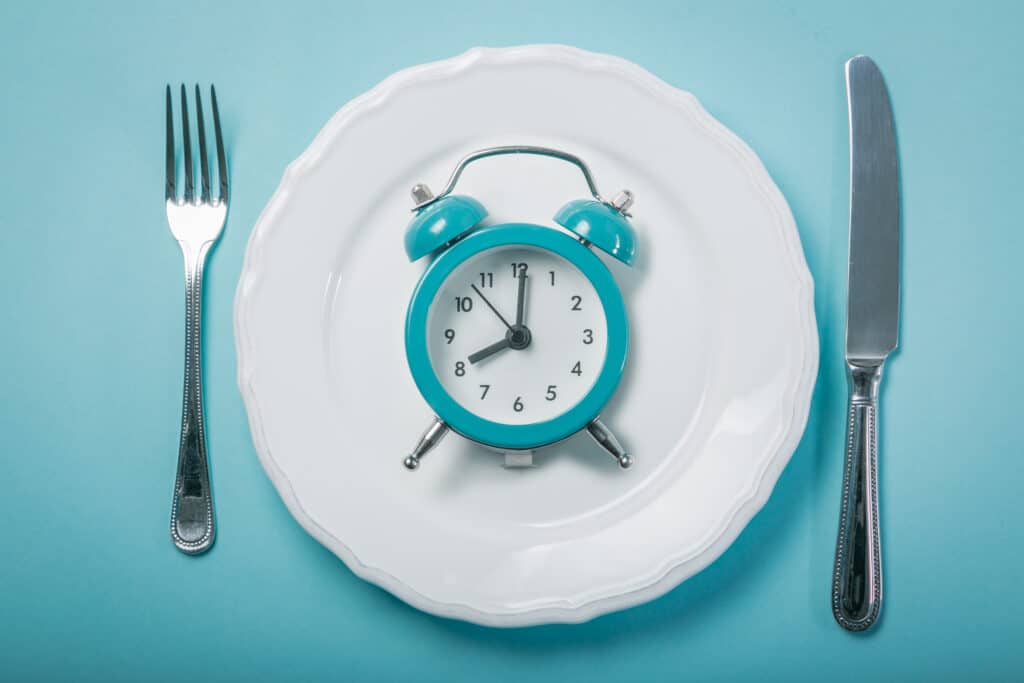This post may contain affiliate links. If you click one and make a purchase, I earn a small commission at no extra cost to you. It helps support the site so I can continue to offer great content to you!

In recent years, intermittent fasting (IF) has gained immense popularity as a distinctive eating pattern. A growing number of individuals are embracing this lifestyle, and with its rise in demand, numerous companies seek to profit from this practice. In this article, we will dive into what you can anticipate when starting intermittent fasting.
For the past five years, I have been practicing intermittent fasting (IF) as an IFer. During this time, I even took a one-year break to assess the impact of stopping IF and solely focused on intuitive eating. Throughout my journey, I’ve explored various hacks, tricks, and tips, leading me to strongly believe that IF can be a valuable addition to the majority of people’s healthy lifestyles. However, it’s essential to be aware of who should avoid attempting intermittent fasting, which will be covered below.
Please note that I am not a medical professional. The information provided in this article is based on my personal research and experience and is intended for informational purposes only. It is crucial to consult with your healthcare professional before making any decisions or changes to your health or lifestyle. Your doctor can provide personalized advice and help you understand what is appropriate and safe for your specific needs.
What is intermittent fasting?
Intermittent fasting, an age-old practice rooted in various cultures throughout history, has garnered attention for its potential to address obesity. Since the early 1900s, researchers have extensively studied this method as a means to combat obesity. Numerous books authored by medical experts have been published, focusing on the benefits of intermittent fasting in tackling obesity and type 2 diabetes.
Following an intermittent fasting lifestyle means that you intentionally incorporate longer periods of fasting (noneating) and digestive rest into the day. Multiple eating and fasting patterns exist. We will review them in the next section of this article.
Dr. Jason Fung made a significant impact in 2012 when he established the inaugural intermittent fasting clinic, aiming to aid patients with type 2 diabetes through this approach. His contributions didn’t stop there; in 2016, he released “The Obesity Code,” a renowned and influential resource within the fasting community. However, it’s worth noting that the book’s content is highly scientific, making it a demanding read for some.
Back in 2016, Gin Stephens emerged in the intermittent fasting realm, having shed an impressive 80 pounds. Her debut book, “Delay, Don’t Deny,” was self-published and marked her entry into the world of intermittent fasting. Since then, she has authored several other books, including “Feast Without Fear,” “Fast Feast Repeat,” and “Cleanish.” Now, eagerly anticipated, her latest work titled “28-Day Fast Start Day-by-Day: The Ultimate Guide” is scheduled for release in late 2023.

What are the different intermittent fasting methods?
The most popular intermittent fasting protocols are the daily eating window (also known as the time-restricted method), alternate-day fasting, the 5:2 protocol, and the 24-hour.
1. Daily eating window
The popularity of this approach stems from its straightforwardness and accessibility. One can easily determine the daily eating and fasting hours according to their preference. Throughout the fasting period, it becomes essential to avoid consuming anything that may affect blood glucose levels or trigger an insulin response. Sticking to plain black coffee, plain tea, or plain water during the fast is crucial, and this practice is commonly known as “clean fasting.”
2. Alternate day fasting
With alternate-day fasting, an individual alternates between days of regular eating and days of fasting. On fasting days, one typically consumes very few calories or nothing at all, while on non-fasting days, they eat as they normally would. The fasting intervals can vary, but commonly, it involves a 24 to 36-hour fasting period followed by a 24-hour non-fasting period. The clean fast is once again crucial. The only difference is the addition of one less than 500 calories meal on the fasting day. All 500 calories must be consumed in one seating and the individual should resume clean fasting when that small meal has been consumed.
3. 5:2 protocol
This intermittent fasting approach entails fasting for two days each week while maintaining regular eating habits on the other five days. Additionally, it allows for a mini-meal containing 500 calories or fewer during the fasting days. After consuming this mini-meal, it is crucial to resume the clean fast for the rest of the fasting day.
4. 24-hour fast
As the name describes, this method of fasting involves a complete non-eating period for 24 consecutive hours. The individual consumes only black and unflavored coffee, plain tea, and plain water for 24 hours. Many individuals will practice this method a few days each week. This more drastic method requires practice and is easier as the body adapts and becomes metabolically flexible.
NEED HELP? I would love to support you in. your journey if you decide that IF is right for you. Join our Serenity Made Easy Facebook community to contact me directly. I am not a Doctor and won’t provide you with medical advice, but would love to help you learn the lifestyle, adopt helpful tips and hacks, and reach your own personal goals.
Why practice intermittent fasting?
There are many reasons for starting intermittent fasting.
The primary and more prevalent reason for adopting intermittent fasting is weight loss. This eating pattern enables the body to naturally benefit from calorie restriction, and it becomes achievable due to the development of metabolic flexibility through intermittent fasting. Unlike conventional diets that involve setting strict calorie goals, which can be challenging, often leaving individuals hungry and fatigued, intermittent fasting teaches the body to efficiently utilize fat for energy, making the process much easier to sustain.
However, there are many other benefits such as:
- Increased focus and concentration
- Increased energy
- Simplicity and adaptability
- Possible heart health benefit
- Prevent, improve, or reverse type 2 diabetes
- Cell repair and longevity
- Reduce inflammation
- Improve metabolism
Who should not do intermittent fasting?
Children and, pregnant and/or breastfeeding women should not do intermittent fasting.
Additionally, anyone with a prior eating disorder should be extremely mindful when considering an intermittent fasting lifestyle. It could be tempting to think that if fasting is good, a more extreme fasting protocol should be better. However, that is not at all the idea and theory behind intermittent fasting.
Lastly, if you are treated for a chronic or temporary medical condition, you should talk to your healthcare team before starting intermittent fasting.
What to expect when starting Intermittent Fasting?
Your body is amazing
As you adjust to intermittent fasting, you will be amazed at how easy and sustainable this method is. You may even discover that your body can address some health issues that you have been dealing with for a while.
By allowing your digestive system to rest during fasting periods, your body can allocate its energy and resources to other vital functions, which can have positive effects on your overall well-being.
Hunger is not an emergency
That’s right! We have been raised to believe that we must react to any and all hunger signals when in fact, there are many benefits that can only be achieved in a fasted state.
Clean fasting matters
Not only to reach all of the benefits of fasting beyond weight loss but also because it makes the fast 100% easier. Just try it.
When starting intermittent fasting, it’s normal to experience hunger pangs. Interestingly, even as you become more experienced with fasting, you may still feel hunger at times. However, the key difference is that your body will adapt and become adept at switching from burning sugar to burning fat for energy. In my personal experience, once this transition occurs, the feeling of hunger tends to subside relatively quickly.
Clean fasting plays a crucial role in teaching your body to become metabolically flexible. By adhering to clean fasting, which means avoiding any food or beverages that might trigger an insulin response, your body learns to efficiently utilize its fat stores for energy. This metabolic flexibility can lead to a smoother fasting experience and may contribute to the overall success and benefits of intermittent fasting.
Body composition
This IF benefit continues to amaze even the most experienced IFers. While you may not see a change on the scale, you may notice you are losing inches and your pants size is decreasing. This is known as body composition.

Weight loss is a slow process
This may surprise you as the headlines are trying to sell you on IF is a fast weight loss protocol. It is not! Intermittent fasting is a lifestyle that doesn’t only provide weight loss. The body literally heals itself with IF. Weight loss will be slow but long-lasting versus all the other fad diets out there.
IF is a lifestyle
You do not start IF with a goal of weight loss for the summer and then going back to “normal”. This is a lifestyle with many non-weight advantages. Think about it, if you lost weight by adding running to your lifestyle, when you stop running, the weight will return. IF is no different. This is why a sustainable, easy to implement in your life weight loss method is crucial if you want forever results.
Mental clarity
This is my absolute favorite benefit of IF. The mental clarity that you get when you are in a fat-burning mode is incredible. I recently went through an intense interview process at work. You can be sure that each of my interviews was conducted in a deep fasting stage.
Energy level
Along the same line, people practicing IF reports having amazing and consistent energy levels throughout the day. This is a big difference from someone who is on a calorie-restricted diet. Again, don’t forget the clean fast which is the key to this.
An amazing community
There is an amazing IFers community out there. Find the right one for you. Receiving support during the adaptation period is crucial. Find people to support in your real life, or in online forums.
Be mindful of Intermittent Fasting communities who recommend radical fasting protocols or suggest that what works for one person will work for everyone. Find a group that understands the science behind fasting and will support you in gentle ways to reach your long-term health goals.
Increased bathroom trips
When you fast, you tend to drink more fluid. Additionally, the digestion process requires a lot of liquid. When you are in a fasted state and not digesting, your body requires less fluid.
A chill in the air
After starting intermittent fasting, you might find yourself unusually cold during the fast. This is not uncommon and not a cause for concern. You might just want to carry a sweater with you.

Bad breath
This happens to some of us IFers and is linked to the fat-burning state. You may have heard of Keto breath, this is the same thing. Because we are clean fasting, a mint or chewing gum isn’t an option, however, quick teeth brushing or simply switching water in our mouth usually does the trick.
Craving veggies
As you advanced in your IF lifestyle, it is not uncommon for your taste buds to change. While the original food freedom might have caused you to eat more sweets, chips, and pastries, most notice a radical change in their food preferences. With less time to eat, your body becomes more picky about what it wants in order to feel its best.
The clean fast allows you to maintain your muscle while losing fat, including dangerous visceral fat.
Not easy at first
IF is easy. However, when first starting intermittent fasting, your body needs to adapt to using fat for fuel. This takes time. Depending on your starting point, this can take a few weeks to a few months.
Once adapted to fasting, you will likely notice that this lifestyle is so easy to sustain long term. You do not need to stop and restart, you simply have a shorter fast or a longer fast. It’s a change in mindset. You do it over and over because it feels good, and gives you the results you want while having complete peace of mind.
Reduce inflammation
IF is known for helping reduce inflammation in the body. People practicing intermittent fasting report less joint pain over time and often better mobility.
Budget-friendly

You read this right. IF may help you save money. With a shorter eating window, you will naturally eat less food. This will more than likely result in adjustments to your grocery list and ultimately save you money.
Time-saver
Not only will intermittent fasting save you money, it will save you time. No more making breakfast, lunch, and dinner. You’ll spend less time in the kitchen and have more time for everything and everyone else in your life.
In conclusion
Starting intermittent fasting may be one of the best gifts to offer yourself. This lifestyle is free, easy and adaptable, and effortless once you become adjusted.
If you would like my help and support during your own IF journey, please join our Serenity Made Easy Facebook group to reach out to me directly.
Also, you can read my own personal journey with intermittent fasting, the struggles I faced, the hacks and tricks I implemented, and the benefits I realized.
Cat xx



